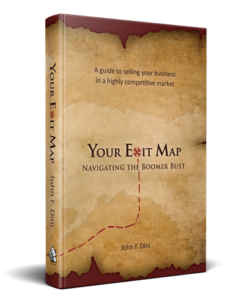Once you understand your company’s value, the next step in planning is to calculate your Distance to Goal. As the Cheshire Cat said, “If you don’t know where you are going, any road will get you there.”
“Any road” is not the way you want to approach the biggest financial event of a career. Distance to Goal calculations require an understanding of where you are now, where you want to wind up, and how long you need to get there. In both industry surveys and my own experience, the majority of business owners have (at best,) only a rough idea of the road they will take.
Calculating Distance to Goal
 Where you are now is a calculation of your current liquid net worth. “Liquid” implies assets, such as stocks and bonds, that you can use for living expenses. Your home isn’t liquid. Income property isn’t liquid, but you can apply the rents to your retirement needs. Don’t include the value of your company at this stage. We’ll get to that in a moment.
Where you are now is a calculation of your current liquid net worth. “Liquid” implies assets, such as stocks and bonds, that you can use for living expenses. Your home isn’t liquid. Income property isn’t liquid, but you can apply the rents to your retirement needs. Don’t include the value of your company at this stage. We’ll get to that in a moment.
Next, you need to calculate how much you’ll need for the next phase of your life. That may be called retirement, but it also might be charitable or community work, satisfying a long-desired wanderlust, or even starting another business. A good financial planner can help you with the assumptions for inflation, longevity and future medical costs.
From a starting point (current liquid net worth,) and a target destination (financial needs at retirement) you can calculate a financial Distance to Goal. Now it is time to choose a time frame.
Add the amount you expect to save each year that you continue working to your liquid assets plus the post-tax proceeds of transferring your company at its current value. Do you reach your goal?
Navigating the Path
With this exercise, some owners are surprised to learn that they are on track, and only need to maintain their current path to realize their objectives. Unfortunately, more find that they can’t reach their destination in the desired time frame without some changes.
This simple triangulation, with a solid starting point, concrete destination and a time frame gives you a clear look at the options available to you. They might include:
- Increase liquid assets: Do you have underutilized real estate? Will you downsize your living quarters once retired?
- Increase savings: Can you make adjustments in your business or your lifestyle to augment what you are currently saving?
- Increase value: Would changes in your business make it more attractive to certain buyers? (That will be post #3 in this series.)
- Increase time frames: Could working a couple of years longer close the gap in your planning?
You can experiment by modeling different scenarios using the free Triangulation Tool at www.YourExitMap.com.
Stephen Covey made famous the phrase “Begin with the end in mind.” If you understand your Distance to Goal, you are better able to choose a road that gets you there.
 Value is the starting point for all transition planning. Any decision, any business plan, and every retirement projection (either for time frames or finances) must start with the value of your business today.
Value is the starting point for all transition planning. Any decision, any business plan, and every retirement projection (either for time frames or finances) must start with the value of your business today. The ownership of their business permeates their relationships. They are, “Bob Smith, the owner of Smith Manufacturing.” Not only in their business circles, but also at their church, in their children’s schools and their friendships. The business is their persona.
The ownership of their business permeates their relationships. They are, “Bob Smith, the owner of Smith Manufacturing.” Not only in their business circles, but also at their church, in their children’s schools and their friendships. The business is their persona. That approach helped the company grow with a balanced customer base. BVA has a presence in food testing laboratories, water and wastewater plants and the Texas oil fields, rather than the typical dominance of doctors and hospitals for their type of business.
That approach helped the company grow with a balanced customer base. BVA has a presence in food testing laboratories, water and wastewater plants and the Texas oil fields, rather than the typical dominance of doctors and hospitals for their type of business.
 For many owners, their biggest concern in an exit plan is maintaining control. Whether they seek to sell to employees, family or a third-party, there is a fear that, once started, the process will have its own rules and momentum.
For many owners, their biggest concern in an exit plan is maintaining control. Whether they seek to sell to employees, family or a third-party, there is a fear that, once started, the process will have its own rules and momentum.